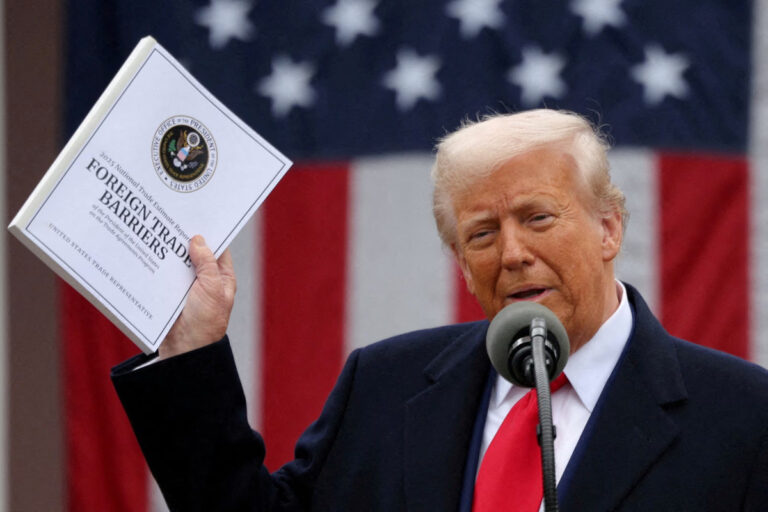🎧 Listen to This Article
BRUSSELS – U.S. President Donald Trump has escalated tensions in the trade standoff with Europe by targeting value-added tax (VAT), accusing it of contributing significantly to America’s near trillion-dollar trade deficit. Trump’s February 13 memorandum lists VAT among the “unfair” taxes on U.S. businesses. But is VAT the culprit behind the U.S.’s trade imbalance? Let’s delve into the arguments surrounding VAT and why Trump has brought it to the forefront of his trade negotiations.
The VAT Debate
In his memorandum, Trump highlights VAT as a significant barrier to U.S. trade, claiming that European countries impose VAT on imports while offering refunds to their own exporters, creating an unfair playing field for American businesses. The U.S. is one of the few countries without VAT, instead relying on a single-stage sales tax that is only imposed at the final transaction point. By contrast, VAT is levied at each stage of the production and distribution process, adding an extra cost to imports that doesn’t exist for domestic products.
White House officials argue that the VAT system’s “double whammy” effect disproportionately impacts U.S. imports. European manufacturers receive VAT refunds when they export goods to the U.S., while U.S. companies face the full burden of VAT when shipping goods to Europe. This, they say, helps explain why Germany exports significantly more cars to the U.S. than the U.S. exports to Germany, a situation that they argue isn’t due to American craftsmanship but rather the tax system.
However, experts like Mairead Warren de Burca, managing director at Alvarez & Marsal Tax in London, point out that many European countries allow importers to defer VAT payments. In some countries, like the UK and the Netherlands, VAT on imports can be avoided altogether at the point of entry, mitigating the cash flow impact on businesses.
Is VAT Really an Impediment to Trade?
While VAT is often seen as a burdensome tax system for non-EU countries, its impact on trade is not as clear-cut as the U.S. administration suggests. In fact, VAT operates similarly to sales tax in the U.S., in that it is ultimately collected on the final transaction, even if it is levied at various stages of the production chain. Importers can usually recover the VAT paid on imports as long as they are registered for VAT in the destination country, which offsets the initial outlay.
Moreover, the VAT exemption for exports, which Trump criticizes, is widely seen as a logical and fair tax policy since VAT is a consumption tax, levied where consumption occurs. This system is designed to avoid taxing exports, ensuring that only consumption within the country is taxed.
The Bigger Picture
While VAT might not be the primary driver behind the U.S.’s trade deficit, the issue of consumption taxes is significant in broader trade negotiations. Zach Meyers, director of research at the Centre on Regulation in Europe, explains that VAT systems in the EU allow countries to reduce other taxes, such as those on production, labor, and corporate profits, which benefits export-oriented industries. The U.S., with its sales tax model, doesn’t enjoy these same advantages, putting American exporters at a competitive disadvantage in markets where VAT is applied.
This trade conflict is not solely about VAT. Trump has used the issue as leverage in ongoing trade talks with the EU, seeking to lower tariffs on American imports and equalize the tax burden for U.S. businesses. One of the sticking points is the significant difference in import duties between the U.S. and EU. For example, the U.S. imposes a 2.5% duty on imported cars, while the EU applies a 10% tariff. When VAT is factored in, this could lead to a total tax burden of 30% for EU-produced cars entering the U.S.
Negotiation Tactic or Real Concern?
Niclas Poitiers, research fellow at Bruegel think tank, believes that Trump’s focus on VAT is more of a negotiating tactic than a genuine concern over global tax policy. While the U.S. administration is looking for ways to bring down tariffs and other trade barriers, overhauling the EU’s VAT system is unlikely to be on the table. Poitiers notes that the EU has repeatedly rejected U.S. proposals to modify its tax system, and there is little appetite to change such fundamental tax structures.
Despite the rhetoric, many analysts view this as part of a broader U.S.-EU trade standoff, with Trump using VAT as a way to push for more favorable terms in trade negotiations, particularly in industries like automotive and technology. The White House may not be genuinely interested in global tax cooperation, but rather in securing trade concessions that benefit U.S. exporters.
Conclusion
As the U.S. and EU continue to clash over trade policies, the role of VAT is likely to remain a key point of contention. While Trump’s focus on VAT may be more about negotiation than genuine tax reform, the ongoing debate underscores the complexities of global trade and taxation. For now, it seems that VAT is simply another weapon in the broader U.S.-EU trade war, one that is unlikely to result in significant changes to the EU’s tax system in the short term.
For further details, clarification, contributions, or any concerns regarding this article, please contact us at editorial@tax.news. We value your feedback and are committed to providing accurate and timely information. Please note that our privacy policy will handle all inquiries



